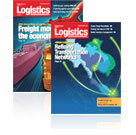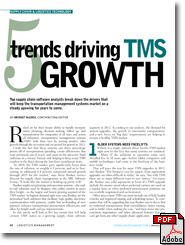Supply Chain & Logistics Technology: 5 trends driving TMS growth
Top supply chain software analysts break down the drivers that will keep the transportation management systems market on a steady upswing for years to come.
Latest Logistics News
Industrial real estate market conditions remain tight, with space in short supply, reports CBRE Freitrater® Freight Rating and Routing Software for Shippers CT Logistic’s SaaS-based TMS platform leverages API’s and technology CT Logistics Employs Qlik® Business Intelligence Software Inspur Information Named IDC Supply Chain Technology Leader More Press ReleasesRelied on for their innate ability to handle transportation planning, decision making, follow up, and measurement for companies of all sizes and across all industries, transportation management systems (TMS) held their own by posting positive sales growth through the recession and are poised for growth in 2012.
Credit the fact that these systems can shave percentage points off of transportation spending, create efficiencies that were previously out of reach, and come in the attractive SaaS (software as a service) format with helping to keep many TMS vendors in the black during the last three tumultuous years.
 “In 2010, the TMS market grew significantly faster than the rate of inflation, or roughly 6.1 percent, and we’re forecasting an additional 6.8 percent compound annual growth through 2015 for the market,” says Steve Banker, service director for supply chain management at the ARC Advisory Group. “It looks like the market is holding up pretty well.”
“In 2010, the TMS market grew significantly faster than the rate of inflation, or roughly 6.1 percent, and we’re forecasting an additional 6.8 percent compound annual growth through 2015 for the market,” says Steve Banker, service director for supply chain management at the ARC Advisory Group. “It looks like the market is holding up pretty well.”
Banker singles out planning and execution systems—the end-to-end solutions used by shippers who utilize carriers to move their freight—as the largest and fastest growing segment of the TMS market. In highest demand right now, says Banker, are the networked SaaS solutions that facilitate high quality electronic communication with partners, enable fast on-boarding of new partners, enhance transportation procurement efficiencies, and allow for freight audit and pay improvements.
In this article we’ll look at five key trends that will help cement TMS’ status as a growing supply chain software segment in 2012. According to our analysts, the demand for system upgrades, the growth in intermodal transportation, and a new focus on “big data” requirements are helping to sustain a healthy TMS market.
1. Older systems need facelifts
If there is a single, primary driver for the TMS market right now it’s the fact that many systems are outdated.
Many of the solutions in operation today were installed five to 10 years ago—before tablet computers and mobile technologies had come to the forefront of the business world.
That will pave the way for more TMS upgrades in 2012, says Banker. “The business case for supply chain application upgrades are often difficult to make,” he says, “but with TMS there are so many different ways to save money.” For example, Banker says solid arguments in favor of a TMS upgrade include the money saved when preferred carriers are used on a regular basis or when preferred procurement positions are successfully negotiated and orchestrated.
Other areas where TMS can assist include use of fully loaded vehicles and improved routing and scheduling tactics. To companies that will be upgrading this year Banker says to focus first on outbound transportation (load consolidation, better routing, and so forth) when making the case, “and then move into procurement negotiations and other advanced features that you can’t get from any other [supply chain] application.”
2. Intermodal in growth mode
Manual and aging transportation management systems may cut it when all shippers have to choose between are truckload and less-than-truckload moves. Throw a few more complications into the ring, however, and a company’s ability to efficiently manage freight movement up and down the supply chain becomes extremely difficult.
The growth in intermodal, which involves the use of more than one mode of transport during a specific journey, makes the situation even more complex. “We’re seeing a lot more companies shipping via intermodal,” says Dwight Klappich, research vice president for Gartner, “and many of the systems that those firms were using in the past don’t fit with intermodal movement.”
The brick-and-mortar manufacturer that begins selling directly to consumers online, for example, will likely find its existing supply chain solutions to be inadequate for handling the new line of business. “Add small-package shipping to the lineup and their TMS will no longer fit,” says Klappich.
The shipper that expands globally will face similar challenges when it tries to manage multiple rail, truck, and ocean shipments. “Intermodal can be a complicated process for the firm that hasn’t dealt with it in the past,” says Klappich, who expects the intermodal trend to continue into 2012. “We’re definitely seeing more of it, as well as a need for a more robust TMS to handle the multidimensional shipping approach.”
3. TMS vendors will go beyond execution
In its 2011 Transportation Management Report, research firm Capgemini Consulting outlined the various components that make up the execution side—as opposed to the planning aspect—of a typical TMS.
Basic execution functions include: order entry and consolidation (registration, validation and management of orders); dispatching (confirmation reports for carriers and/or drivers); order status information (recording information related to the pickup, collection and delivery of shipments); global logistics execution (customs and transport documents); and yard/parcel management.
As evidenced by Capgemini’s report, the execution component of a TMS covers a lot of valuable ground for shippers, but that hasn’t stopped vendors from coming up with new additions that push their systems beyond the basics. “One of the biggest trends we’re seeing right now are TMS that are trying to be more than just execution systems,” says Chris Caplice, executive director at Massachusetts Institute of Technology’s Center for Transportation and Logistics.
“Basically, a TMS gathers the information on a load to be tendered and matches that data to a historical routing guide. Then it communicates to a carrier and manages the ensuing communication process,” says Caplice. “The more advanced TMS is going beyond that and tapping into other information services and utilizing that data to help the shipper make the best possible decisions.”
For example, he says that the TMS can be connected directly into a market data benchmarking service that funnels data back to the system. “The addition of this automated, real-time market monitoring function helps shippers avoid the yearly or biannual carrier bidding process,” says Caplice, “positioning the TMS to serve as more than just an execution feed.”
4. Systems equipped to handle big data
Defined as the datasets whose size is beyond the ability of typical database software tools to capture, store, manage, and analyze, “big data” is big business in today’s corporate environment.
According to McKinsey Global Institute, enterprises globally stored more than 7 exabytes (one exabyte = one quintillion bytes) of new data on disk drives in 2010. That number is expected to grow as companies capture trillions of bytes of information about their customers, suppliers, and operations.
Managing the data isn’t easy, but MIT’s Caplice says TMS vendors are stepping up to the plate and developing systems that make valuable use of the “big data” that is collected and stored.
“TMS is going beyond just being tendering systems,” says Caplice, who points out that transportation as a whole tends to generate rich transactional data. By drilling down into specific regions or focusing on particular market trends, for example, shippers can utilize the “big data” stored in their TMS to make educated business decisions—the placement of new DCs, for instance. “Companies are really only starting to tap into this function, but it’s something that I definitely see continuing to gain momentum in 2012,” says Caplice.
5. More holistic solutions
Intent on becoming one-stop-shops for the shippers that they serve, today’s third party logistics providers (3PLs) view TMS as an important addition to their vertically integrated service offerings.
“We’re seeing a lot more 3PLs trying to come up with TMS systems that their customers can implement,” says Ellen Chen, MOVE practice leader at Capgemini. “Those customers can then save money by consolidating and ‘sharing’ those systems with other shippers or suppliers.” Those shippers that take the 3PL route also gain the benefit of a full-blown TMS without the need for maintenance or management.
Chen says that the trend blends well with a broader push to create holistic transportation systems that are consolidated under one roof, rather than being sold, installed, and managed by multiple vendors. She’s working with a vendor right now that’s developing a “cookie cutter” TMS targeted for the small- to medium-sized enterprise that wants complete functionality without the high purchase and maintenance costs.
“We’re seeing a lot more RFPs being issued by shippers seeking holistic transportation management systems,” says Chen. “They want deeper, broader solutions without the extreme costs, and they see this as a way to meet that goal.”
Bullish on TMS vendor’s ability to achieve a 6.8 percent growth rate over the next few years, ARC’s Banker says yet another trend that’s propelling the industry right now is demand for TMS coming from non-traditional industries.
“It used to be that TMS sales were highly concentrated in consumer goods, food and beverage, retail, and electronics,” says Banker. “Other industries are now taking an interest and realizing that even a modest 5 percent savings—afforded by a solid TMS—is a pretty good return on investment for this type of software.”

Article Topics
Press Releases News & Resources
Industrial real estate market conditions remain tight, with space in short supply, reports CBRE Freitrater® Freight Rating and Routing Software for Shippers CT Logistic’s SaaS-based TMS platform leverages API’s and technology CT Logistics Employs Qlik® Business Intelligence Software Inspur Information Named IDC Supply Chain Technology Leader Norfolk Southern rolls out details of strategic company plan Supply Chain Technology: Cloud computing breakthrough More Press ReleasesLatest in Logistics
Investor expectations continue to influence supply chain decision-making The Next Big Steps in Supply Chain Digitalization Warehouse/DC Automation & Technology: Time to gain a competitive advantage The Ultimate WMS Checklist: Find the Perfect Fit Under-21 driver pilot program a bust with fleets as FMCSA seeks changes Diesel back over $4 a gallon; Mideast tensions, other worries cited Four U.S. railroads file challenges against FRA’s two-person crew mandate, says report More LogisticsSubscribe to Logistics Management Magazine

Find out what the world's most innovative companies are doing to improve productivity in their plants and distribution centers.
Start your FREE subscription today.
April 2023 Logistics Management

Latest Resources















